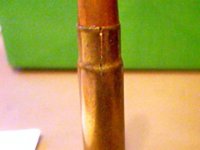After rereading the Wikipedia article I linked to, I am more convinced it is a bad idea to use Brasso or other ammoniated cleaners on it, despite the relatively brief exposure. If you do, what is protecting you is not case annealing but the fact you are not storing the brass in high humidity.
Below is a Wikipedia photo of a season cracked case by contributor DrHenley, taken 2003 and uploaded to the Wikipedia in 2010 and shared here under the Wiki Commons rules for sharing images. His description says:
DrHensley said:
The case had been polished with Brasso, which contains ammonia, and then stored in high humidity for several years.
What you can learn from that image is that annealing, alone, does not prevent season cracking unless there is little or no stress from a seated bullet stretching the brass. It does nothing to prevent weakening of the brass by ammonia and moisture. It just reduces the total amount of stress from work hardening plus a bullet expanding the neck stress to just the latter, alone, so it takes longer for cracks to appear.
The military loaded its old 30-06 by painting a solution of asphaltum (pitch) and mineral spirits on the inside of case necks and letting the mineral spirits dry off. After the pitch dried, the bullet was seated. The asphaltum gripped the bullet, but there is no stress on the neck from an interference fit as is used in commercial ammunition and handloading today. I have pulled down both 1964 National Match ammunition and 1920's and 30's M1 Ball ammunition, and except for the crimp in the later, they are made the same way. If you use mineral spirits to remove the pitch from the bullet and from inside the neck of the case (and the crimp from the M1 Ball), you find the bullet is a slip-fit into the case neck and you can easily move it in or out by hand. The pitch, after drying, is like a high viscosity semi-liquid and the presence of the bullet flattens it out, so you don't have as much radial pressure against the inside of the neck, stressing it, as holding a bullet by an interference fit with the neck does. Annealing only prevents season cracking under the condition that there isn't significant stress on the neck from a bullet seated under it.
The other factor with military ammunition is that in the 1920's, Hatcher put polished cases (cleaned by dipping in 5% citric acid solution and then tumbling them) as the original arsenal practice had been and took them and some cases that had not been polished after manufacturing and set them on the roof of the Frankford Arsenal for a year. At the time, the atmosphere in that part of Philadelphia was quite corrosive due to chemical plants and sulfur from coal burning in the air. After that year passed, the polished brass was eaten away but the unpolished brass was still in good shape, illustrating that the oxides from production and annealing were actually good protection for the brass. This will have helped resist ammonia as well, by creating a kind of sacrificial oxide coating. So this is another arena in which the military ammunition's immunity to season cracking is unlike what you get in most commercial ammunition. Only cases like Lapua or IMI that have the annealing stain and oxides intact will have that added corrosion resistance.
So, what's going on with ammonia?
The name "season cracking" comes from the fact the problem would appear on cartridges during the monsoon
season, when humidity was high enough to keep ammonia and copper compounds ionized. That allows surface ammonia damage to spread into the metal in the same way rust grows to pits. Just as rust will not occur on steel in low humidities, neither will ammonia damage continue to progress below the surface of a copper alloy in its absence. So it wasn't the ammonia exposure during the monsoon season that weakened the brass to make it split then. Rather, the high humidity allows ammonia damage at the surface to penetrate deep into the brass by ionizing it. It was the near 100% relative humidity during that season's constant rains and was reasly what caused the damage to progress to the point the necks split the necks.
Anyway, the lesson here is that short exposure to ammonia in Brasso will likely not harm your cases if you don't keep the polished brass in anything but lower humidities. However, if you do take it out into high humidity subsequently, the possibility of season cracking returns, as it may activate the ammonia damage at the surface and have it start penetrating deeper into the neck. It may not be weak enough to split spontaneously, but may, instead, split on firing.
Bottom line, ammonia and humidity work together to weaken brass. Splitting is caused by stress in brass that has been thus weakened. It may be hard to tell if a split neck observed after firing occurred entirely because of overworking the brass without annealing or if the weakening was partly caused by ammonia and humidity exposure.
Oxides
In the first photo below, you can see, especially on the left end, black
cupric oxide behind verdisgris and blooming. This was caused when the brass got wet in a garage and stayed that way for a long time. Below it is the brass after cleaning in a heated ultrasonic bath in a 5% citric acid solution. There is pink from
cuprous oxide left behind on some of them, but it is very thin and polishes off in the tumbler in about 15 minutes. I mounted a needle on a dial indicator and probed the pits from the oxide and about 0.002" was the deepest. The black oxide did not get below the surface. All that brass was subsequently loaded and fired repeatedly without incident.

